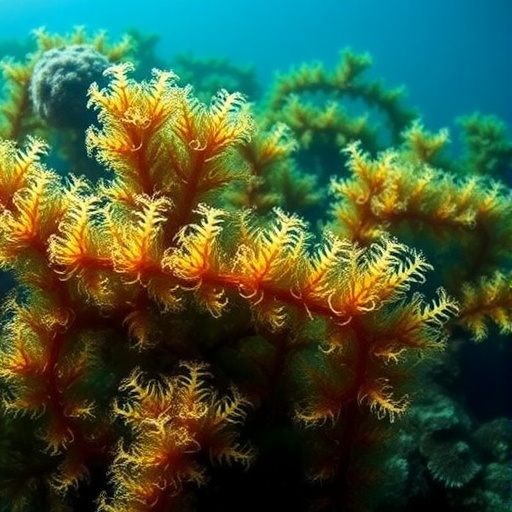The ocean, vast and mysterious, conceals within its depths a complex web of life crucial not only to marine ecosystems but to the very air we breathe. At the heart of this intricate system lies phytoplankton, microscopic algae that serve as the primary producers in the marine food web. These tiny organisms perform photosynthesis, converting sunlight into energy and releasing oxygen—a process foundational to life on Earth. Recent groundbreaking research from Rutgers University has illuminated a critical piece of this global puzzle: the role of iron as an essential micronutrient governing photosynthetic efficiency in natural phytoplankton communities.
For decades, scientists have understood that iron is vital for photosynthesis; it acts as a key component in various enzymatic reactions involved in the conversion of light energy to chemical energy. However, much of this understanding stemmed from laboratory experiments that, while insightful, could not fully capture the complexity of natural marine environments. Iron in the open ocean is typically scarce, delivered primarily through atmospheric dust from arid regions and via glacial meltwater, making it a limiting nutrient in many areas. This scarcity has significant implications for phytoplankton’s ability to sustain photosynthesis, carbon fixation, and thus the broader marine food chain.
In a pioneering voyage spanning 37 days through the Southern Atlantic and Southern Oceans, Rutgers graduate student Heshani Pupulewatte embarked on a mission to unravel how iron limitation alters photosynthesis within these microscopic algal populations in situ. Armed with specially designed fluorometers constructed by her lab colleague Max Gorbunov, she measured fluorescence signals emitted by phytoplankton when their photosynthetic apparatus is under stress or damaged. These fluorescence patterns offer a window into the efficiency of energy transfer within the photosystems—complex protein structures responsible for harnessing sunlight.
The study revealed that when iron is insufficient, up to a quarter of the light-harvesting proteins within phytoplankton become decoupled from the reaction centers where energy conversion occurs. This decoupling causes a notable reduction in photosynthetic efficiency and an increase in wasted light energy released as fluorescence. Significantly, by supplying iron to sampled waters, the researchers observed a rapid reconnection of these proteins, effectively restoring the energy transfer process and allowing phytoplankton to resume normal photosynthetic functions.
This molecular-level understanding of iron limitation’s effect on phytoplankton photosynthesis is revolutionary, as it moves beyond controlled lab conditions to natural ecosystems. It underscores iron’s integral role in regulating primary production in vast oceanic regions, particularly the Southern Ocean, a crucial sink for atmospheric carbon dioxide. The impact extends up the food chain, as phytoplankton are the dietary cornerstone for species such as krill, which feed myriad predators including penguins, seals, and whales. Disruptions in phytoplankton productivity could therefore resonate throughout marine biodiversity.
Compounding these challenges, climate change is altering wind patterns, rainfall, and ocean currents, thereby influencing the deposition of iron-rich dust and glacial inputs into the sea. According to Paul G. Falkowski of Rutgers University, a co-author of the study, these shifts may exacerbate iron limitation, reducing photosynthetic oxygen production and carbon sequestration efficiency. While humanity remains unaffected in terms of breathable oxygen at present, the ecological consequences for ocean life and global carbon balance could be profound.
The methodological innovation of real-time fluorescence measurement aboard a research vessel is itself a leap forward, allowing scientists to gauge photosynthetic stress without the need for transporting samples to shore laboratories. This capability not only improves accuracy but also enables timely responses to changing ocean conditions. The approach provides a powerful tool to monitor ocean health and the intricate biochemical cycles underpinning it.
Moreover, this research provides a critical baseline for modeling future scenarios under various climate change trajectories. Detailed knowledge of how nutrient limitation constrains photosynthesis at the molecular scale enhances predictive accuracy regarding ocean productivity, carbon cycling, and ecosystem shifts on a global scale. Understanding these processes is imperative as policymakers and conservationists strive to mitigate climate change and preserve marine resources.
Beyond the ocean’s surface, these findings have ramifications for global biogeochemical cycles. Phytoplankton play an outsized role in drawing down atmospheric CO2, acting as a vital component of Earth’s carbon sink. Iron availability governs this function; thus, the research sheds light on how disruptions in micronutrient supply could feedback on atmospheric carbon levels, influencing climate dynamics.
This comprehensive field-based study bridges the gap between molecular biology, oceanography, and ecology, demonstrating the intertwined nature of Earth’s systems. By charting a close-up view of photosynthesis under natural nutrient stress, it invites further exploration into how elemental cycles shape life from microscopic cells to planetary scales.
As our understanding deepens, so too does the urgency to monitor and protect these essential marine processes. The intricate dance of light, nutrients, and life beneath the waves holds answers to questions about Earth’s past, present, and future resilience to environmental change. The Rutgers study marks a significant milestone in decoding this dance, offering hope that with knowledge comes the ability to act wisely.
Subject of Research:
Not applicable
Article Title:
Coupling of excitation energy to photochemistry in natural marine phytoplankton communities under iron stress
News Publication Date:
29-Jul-2025
Web References:
https://www.pnas.org/doi/10.1073/pnas.2511916122
References:
Rutgers University study published in Proceedings of the National Academy of Sciences
Image Credits:
Brandy Robinson / GEOMAR Helmholtz Centre for Ocean Research Kiel
Keywords:
Photosynthesis, Marine biology, Iron




